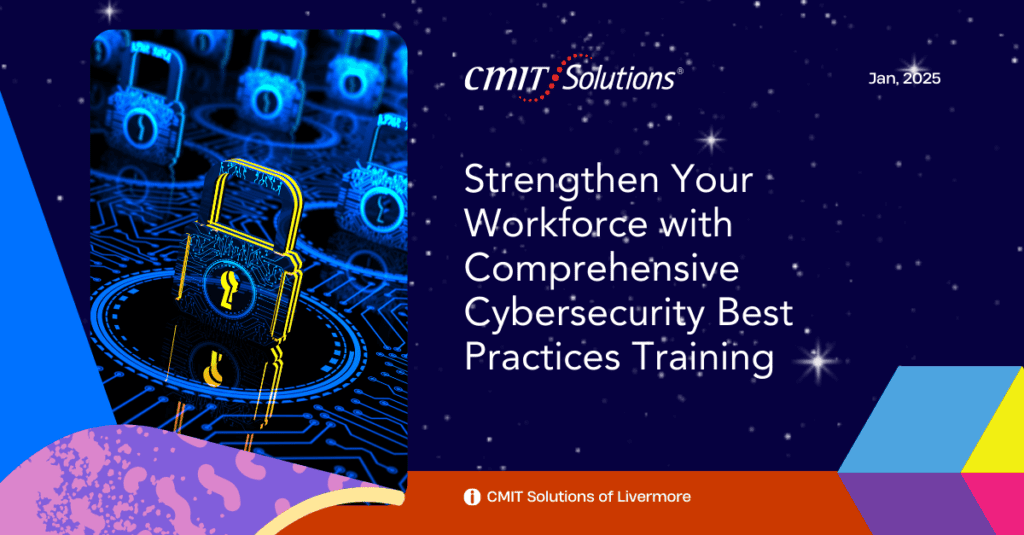Strengthen Your Workforce with Comprehensive Cybersecurity Best Practices Training
In today’s rapidly evolving digital landscape, the risks to your business’s sensitive data and systems are greater than ever. While your IT team may have the expertise to mitigate these risks, the rest of your workforce often lacks the awareness or knowledge to prevent cyber incidents. For CMIT Solutions of Livermore, empowering your entire team with cybersecurity best practices training is not just a good idea – it’s essential.
Why Cybersecurity Training is Crucial
Your employees are the first line of defense against cyber threats. They don’t intend to cause harm, but a lack of awareness can lead to mistakes that compromise your network and data. Training ensures that everyone understands their role in safeguarding the company’s digital assets, reducing vulnerabilities, and responding effectively to threats.
With ongoing cybersecurity training, your team can:
- Recognize phishing attempts and avoid falling victim to scams.
- Understand the importance of strong password practices.
- Implement data protection strategies.
- Stay up to date with evolving cyber threats.
How To Provide Effective Cybersecurity Training
Move Beyond Onboarding Basics
While most companies include basic cybersecurity training during onboarding, this approach has limitations:
- Information Overload: New hires often receive a deluge of information in their first week, making it challenging to retain critical details about cybersecurity.
- Evolving Threat Landscape: Cyber threats are constantly changing. A one-time training session can quickly become outdated.
To address these challenges, CMIT Solutions of Livermore recommends ongoing training programs that reinforce key concepts and introduce new strategies as threats evolve. Refresher sessions help employees maintain good habits and stay prepared for emerging risks.
Key Topics for Cybersecurity Training
To build an effective training program, focus on practical, understandable topics. Tailor the content to your employees’ technical knowledge, ensuring that everyone can relate to and apply the information. The most important topics to cover include:
1. Security Policies
Employees need clear guidelines on what is acceptable and unacceptable behavior when using company devices and accessing company data. Cover:
- Device usage policies.
- Internet and email usage rules.
- Secure file sharing practices.
Learn more about Compliance services for creating robust security policies.
2. Incident Response Procedures
Training should include a clear plan of action for employees to follow if they suspect a security breach. Key elements include:
- Recognizing signs of a cyber incident.
- Reporting incidents to the appropriate team.
- Containing and mitigating threats.
3. Password Management
Weak or reused passwords are among the most common vulnerabilities. Teach employees:
- How to create strong, unique passwords.
- The importance of using a password manager.
- The risks of sharing passwords.
IT Support services can help implement secure password management solutions.
4. Phishing Awareness
Phishing remains one of the leading causes of data breaches. Provide training on:
- Identifying phishing emails and messages.
- Safely handling suspicious links or attachments.
- Reporting phishing attempts to IT.
Explore how Cybersecurity services can protect your business from phishing threats.
5. Data Protection
Employees should understand the basics of protecting sensitive data, including:
- Encrypting files and emails.
- Using secure file-sharing platforms.
- Avoiding public Wi-Fi for work-related activities.
CMIT Solutions of Livermore offers Data Backup solutions to safeguard your critical information.
6. Threat Detection and Response
Equip your team with the knowledge to identify and respond to potential threats, such as:
- Unusual system behavior.
- Unauthorized access attempts.
- Suspicious software installations.
Approaches to Cybersecurity Training
Effective training requires diverse methods to engage employees and reinforce key concepts. Consider these approaches:
1. Simulated Phishing Campaigns
Conduct mock phishing tests to evaluate employees’ ability to recognize and avoid phishing attempts. Use the results to identify areas for improvement.
2. Asynchronous Training Modules
Offer online training sessions that employees can complete at their own pace. This approach accommodates different schedules and learning speeds.
3. In-Person Training Sessions
Host interactive workshops or seminars to provide hands-on learning experiences. Encourage employees to ask questions and share their concerns.
4. Regular Updates and Newsletters
Send out periodic emails or newsletters highlighting recent cybersecurity trends, tips, and reminders. This keeps cybersecurity top of mind.
5. Video Tutorials
Create engaging video content that explains complex topics in simple terms. Visual aids can help reinforce key messages.
Discover how Productivity Applications can support your training initiatives.
Benefits of a Well-Trained Workforce
By investing in comprehensive cybersecurity training, your business can:
- Reduce Risk: Educated employees are less likely to make mistakes that lead to breaches.
- Improve Incident Response: Trained staff can act quickly to contain threats.
- Enhance Compliance: Stay aligned with industry regulations and avoid penalties.
- Boost Employee Confidence: Empowered employees feel more confident and engaged in their roles.
Best Practices for Cybersecurity Training
To maximize the effectiveness of your training program, follow these best practices:
- Make It Relevant: Tailor content to your industry and specific business needs.
- Keep It Simple: Avoid jargon and focus on practical, actionable advice.
- Be Consistent: Schedule regular training sessions to reinforce key concepts.
- Encourage Feedback: Allow employees to share their experiences and suggestions for improvement.
- Incorporate Real-World Examples: Use case studies and examples of recent breaches to illustrate the importance of cybersecurity.
Learn how Unified Communications can facilitate effective training and collaboration.
Conclusion
Cybersecurity is a team effort, and every employee has a role to play in protecting your business. By providing ongoing training in cybersecurity best practices, you equip your workforce with the knowledge and skills to prevent breaches, respond effectively to threats, and maintain the integrity of your systems and data.
At CMIT Solutions of Livermore, we understand the importance of a well-trained workforce. Our Managed Services and IT Guidance solutions include customized cybersecurity training programs to meet your unique needs. Contact us today to learn how we can help you build a secure and resilient organization.
Contact Us to get started with tailored cybersecurity solutions and training for your team.



